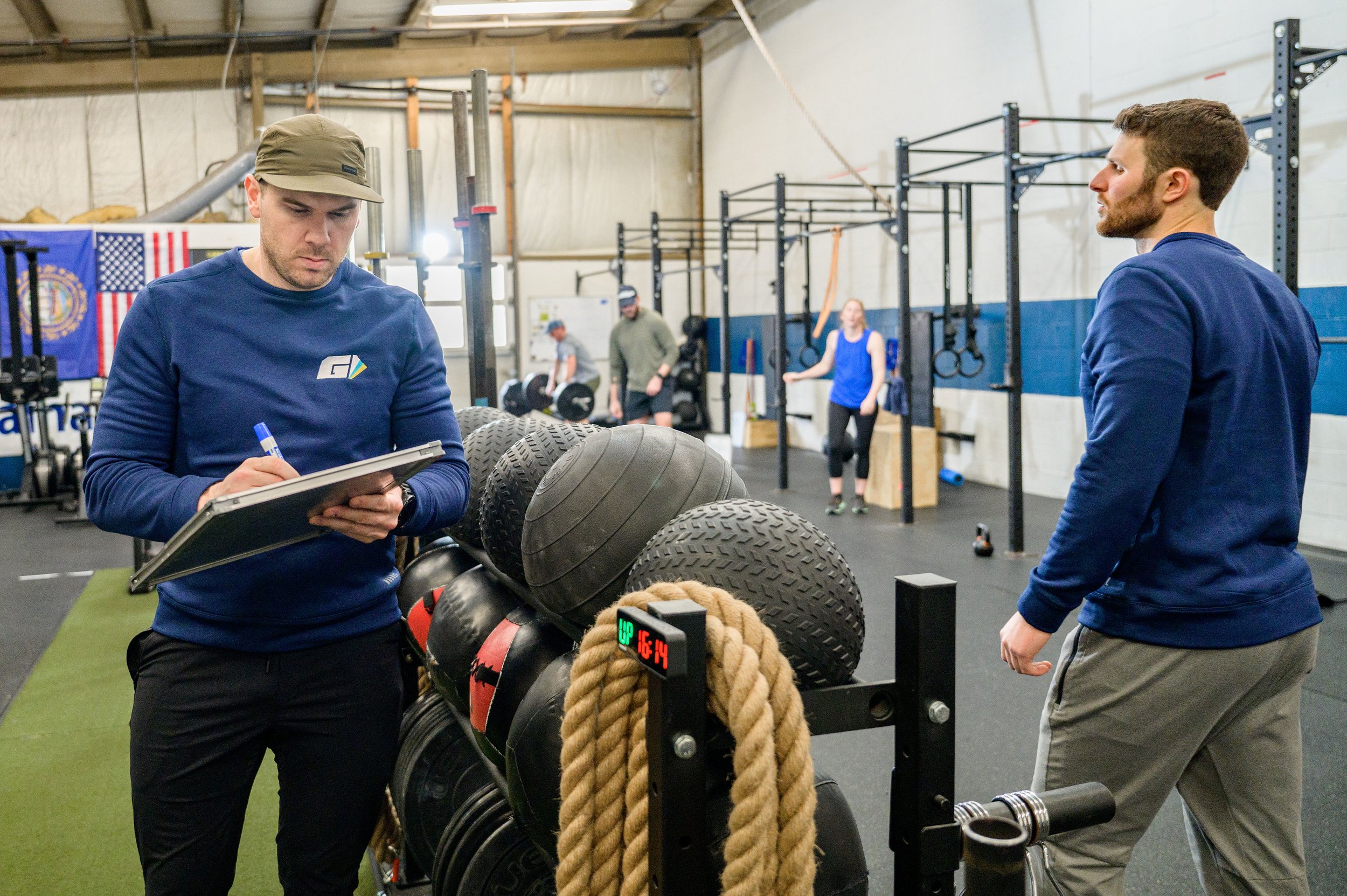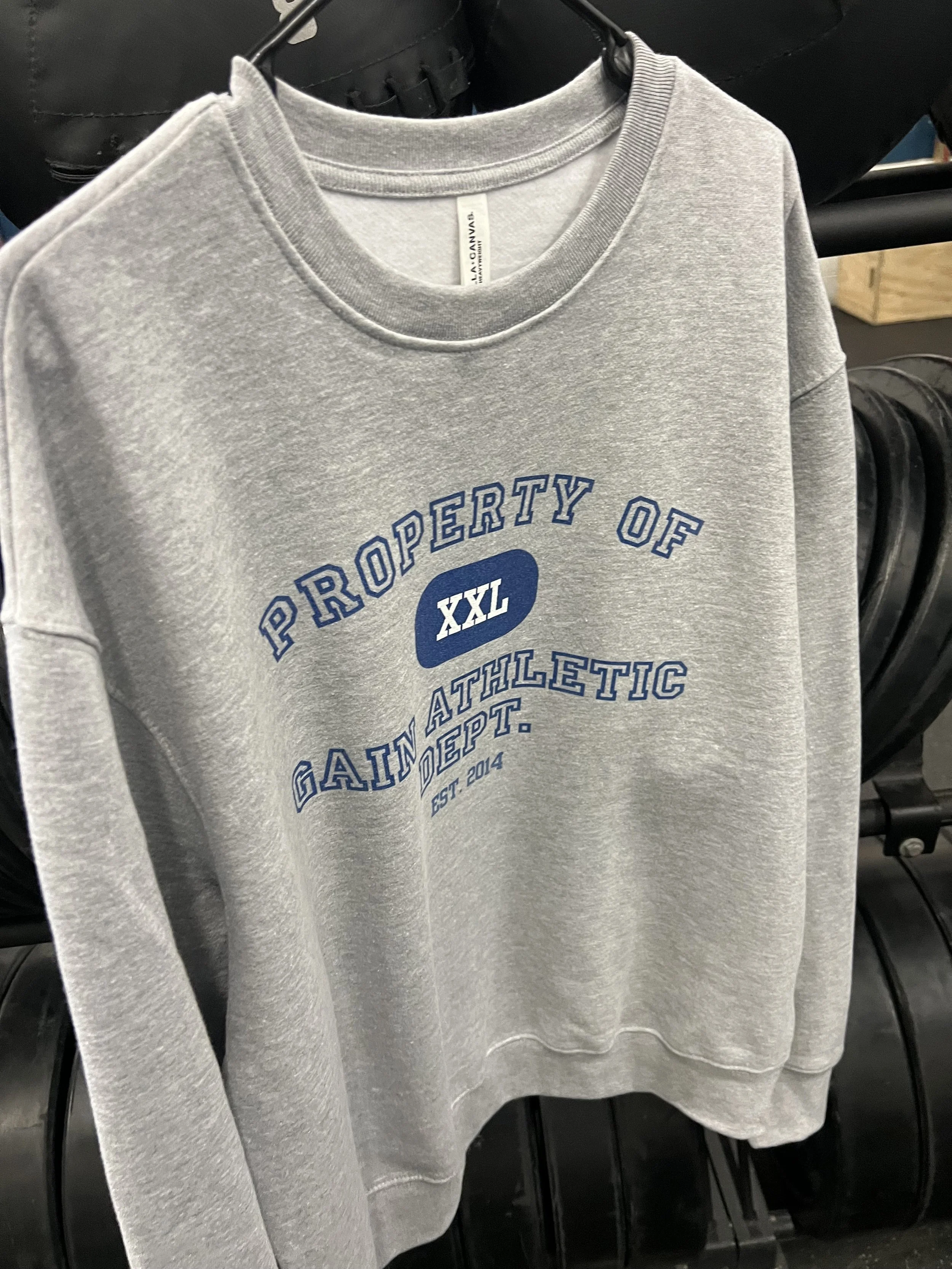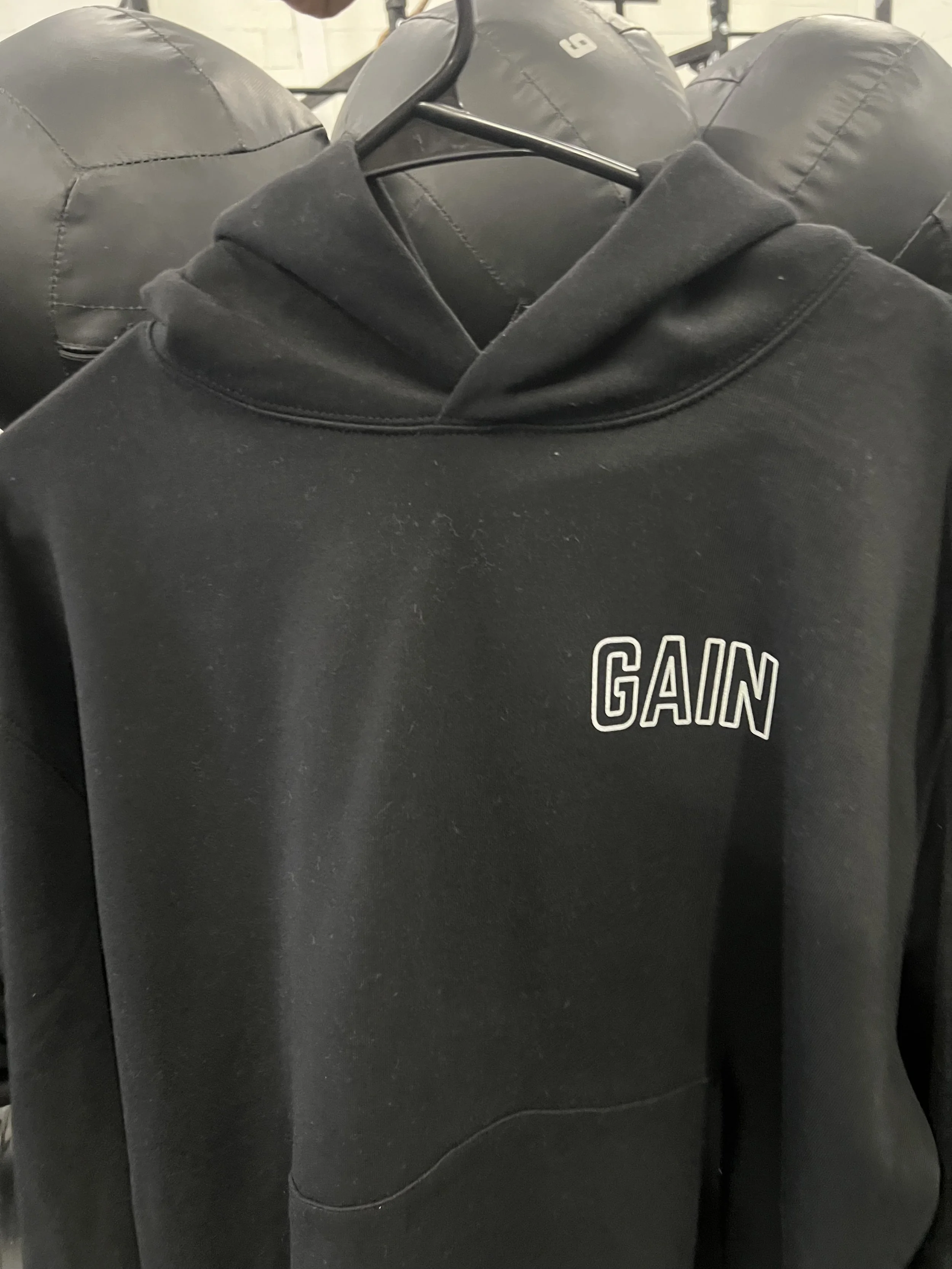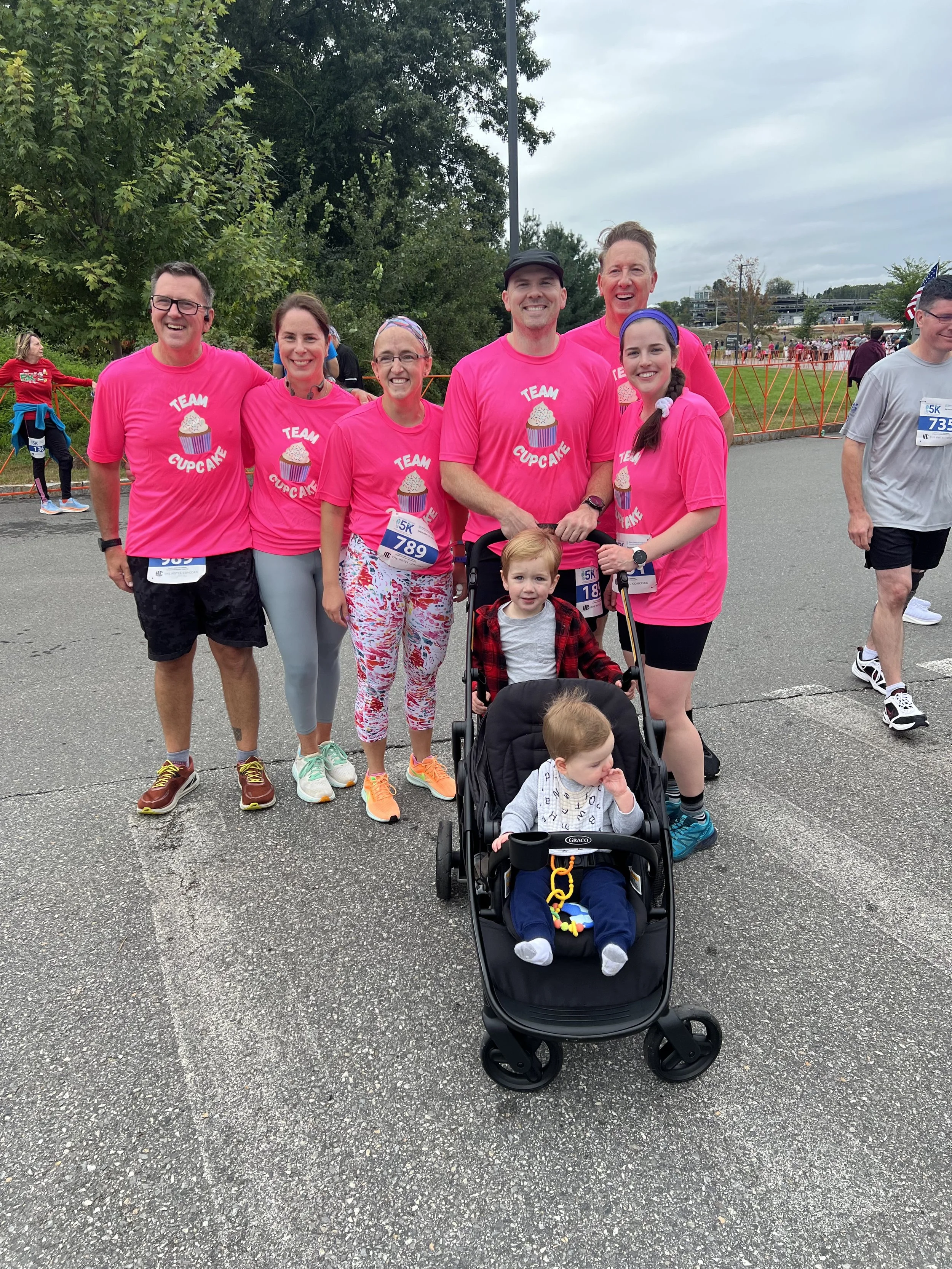
Welcome to the GAIN Blog
The blog is updated Monday-Friday. Tune in for posts and discussion about health, fitness, nutrition, training experiments and reflection. We share articles, videos and more. We post the link to our Instagram story every day, make sure to follow along there to never miss a post.
Take a Seat
How comfortably can you sit on the floor? Criss-cross style — no problem? Or does your back start yelling at you after 30 seconds?
I’m a fan of simple things that improve your health without getting in the way of your life. One of those things: occasionally choosing the floor instead of the couch.
It’s a chance to tinker with your movement. To notice if your hips rotate, your spine moves, and your ankles actually work. No equipment needed — just sit. Shift around, explore positions, feel the stretch. When you’re done, climb back on the couch.
It’s a foolproof way to get a little more movement, better mobility, and a skill you used to own as a kid but lost somewhere along the way.
— Justin Miner
3-session trial
At GAIN, new members don’t just jump into random workouts. We start everyone with a 3-Session Trial. It’s your chance to meet our coaches, experience the GAIN vibe, and see how our individualized approach works. We’re not a group class, but we’re not one-on-one personal training either—we’re something different, and unlike any gym you’ve been to.
Session 1: The Intro Workout
Work closely with a coach on breathing, bracing, range of motion, and stability.
Talk through your injury history, training background, and goals.
Leave feeling like you could do more—we ease you in so you can build a habit that lasts.
Learn the foundations: squat pattern, push-ups, ring rows, and key core drills.
Session 2: Building On It
Add more movements and get your first taste of conditioning (cardio).
Learn our favorite cool-down mobility drills.
Focus on pressing and pulling with the upper body plus single-leg training.
Session 3: The Hinge & More
Learn the hinge pattern—a cornerstone movement for strength and longevity.
Revisit and reinforce previous skills.
Expect a slightly bigger workout as your body adapts.
Why It Matters
Over three sessions, you’ll get a crash course in all things GAIN:
Learn our favorite exercises.
Get real coaching and movement breakdowns.
Leave with a plan that’s unique to your needs and goals.
It’s more than just a trial—it’s the start of moving better, feeling stronger, and getting connected to your training.
Ready to get started? Come see what GAIN is all about HERE.
—Justin MIner
Big Breath dRill
Breathing is important. The hard part is getting people to actually focus on it. Breathing can feel boring, even uncomfortable, because your brain is usually running a million miles an hour and slowing down is tough. That’s why I’ve found simple drills work best.
Here’s one you can try this week.
Why focus on breathing?
A few minutes of focused breathing can:
Improve mechanics. Treat it like a mobility drill for your whole body. Better breaths unlock better positions.
Change your state. Depending on the sequence, a few minutes of breathing can help you chill out or fire up. This drill is more about feeling awake.
Improve posture. When you know what a good breath feels like, you’re less willing to trade it away to poor positions.
I could tell you to “use your diaphragm” or “expand into your ribs and back,” but honestly, that often complicates things. The best way to get better at breathing is just to practice filling up as much as you can.
At first, you’ll probably breathe mostly with your chest and shoulders. But as you get more reps in, you’ll pull in more air, feel expansion throughout your whole trunk, and improve your mechanics. After a long exhale and hold, the next breath will be even better.
The Drill
Lay on your back, feet up on a wall.
For 90–120 seconds, take big, deep, expanding breaths with a sharp, quick exhale.
Exhale all the way on your last breath, then hold.
Breathe again when you’re ready.
Repeat for 2–3 rounds.
The longer you can hold that exhale, the better your next round will feel.
Give it a shot this week.
—Justin Miner
Monday Check In
I missed a lot of training this past month. I’m finally feeling normal, and now I’m in that familiar spot we all hit sometimes: resisting the urge to make up for lost time.
Just because you could doesn’t mean you should.
The temptation is to cram in missed workouts and “catch up.” Instead, I’m choosing the slow ramp: shorter sessions, fewer total sets, easy aerobic work, and lots of patience. Doing too much too soon is the fastest way to end up…missing more.
It’s frustrating, sure. But the long game always wins.
Happy Monday, here’s to a good, sustainable week ahead.
—Justin Miner
Friday Thoughts 97
Greetings! Welcome to this week’s edition of Friday Thoughts, where I share what’s been on my mind and in my feed throughout the week. Enjoy!
Sleep
I’m coming off the two best nights of sleep I’ve had in a month. I have lots of thoughts and theories, obviously, but I’m not getting into them today because I slept in and got to get moving!
Perfect Pun
No explanation needed, this is gold.
Running cue
This is a nice running cue to visualize. Getting the arm swing right can be tricky.
The GOAT PB
Teddie is the best peanut butter, hands down, no question about it.
Thanks for reading, me and the boys are coaching the 4pm class tonight, see you there!
—Justin Miner
Gym Lingo: Iso Hold
“Iso hold” is short for isometric hold.
And isometric is short for isometric contraction.
An isometric contraction is when a muscle contracts but the muscle length doesn’t change. In other words, your muscles are working without any joints moving. Instead, the contraction keeps everything in place.
Think of it like this:
Sitting tall in a chair with perfect posture means you’re isometrically contracting lots of muscles at once.
Holding a plank (when done well) is a classic isometric contraction.
Even during a pause squat or a bench press with a pause, your muscles are firing isometrically while you hold that position.
At GAIN, some of our most common iso holds are:
Split squat iso holds
Anti-rotation press iso holds
Bottom of push-up holds
Wall sits
And if you were around for our Zoom workouts… bat wings
Why do we use them?
Iso holds make you stronger in specific ranges of motion.
They help build strength and rigidity.
They’re also a fantastic way to train around an injury when big ranges of motion aren’t possible.
Iso holds are simple, brutally effective, and one of those training tools that never really go out of style.
—Justin Miner
Training vs Working out/specific and non specific goals
One of our clients just came back from something she had been training for all summer—a canoe trip. Her goal wasn’t to race or set records; she wanted to feel confident getting in and out of a wobbly canoe and make it through a couple of long days of paddling.
Before the trip, her “goal” was more tongue-in-cheek: to age gracefully. Vague, yes, but it got her in the gym twice a week for a year. Once the trip was on the calendar though, that goal turned into something specific—survive the trip—and that gave her the motivation to push harder in the gym.
Now the trip is over, and she told me, “I need another goal!” Part of me agrees. But part of me thinks it’s time to shift back to the bigger, non-specific goal—training for the long game of aging well.
This brings up an important distinction:
Training = working toward something on the calendar. A race, a trip, a PR. Specific.
Working Out = maintenance. Holding on to what you’ve built. Keeping the wheels from falling off. Less specific.
Both matter. We can’t always be chasing the next event, but we also can’t just drift without ever checking in on how we’re doing. The longer you play the game, the more valuable this distinction becomes.
When I was younger coach and athlete I believed you should always be training. Always have a target. But over the years, I’ve learned the downtime is important too. There’s value in training without a looming deadline. Honestly, it’s refreshing to not be chained to a strict program year-round.
The trick is knowing when it’s time to sharpen your focus and when it’s time to step back.
—Justin Miner
No homework required
New people always ask me for homework between their gym sessions. My answer? Go for a walk.
When you’re just learning strength training, chances are you’re still breaking old habits and figuring out good form. Without a coach’s eye, extra reps at home usually mean sloppy practice—and sloppy practice just reinforces bad habits. Quality > quantity.
If you’re brand new, training twice a week is enough. Even with big goals, three times a week is enough. More isn’t better—it’s just more.
So ditch the pressure to do extra. If you want to move more, great, go for a hike, hit a yoga class, mow the lawn, or toss a kayak on the roof of your car. There are endless ways to practice movement without piling on bad reps.
—Justin Miner
Monday Check in
Happy Monday!
Another chance to start the week off fresh. What are you going to accomplish this week? What are your big plans? What are you thinking about doing or trying this fall?
There’s 107 days left in 2025, take advantage of it!
-Justin Miner
Friday Thoughts 96
Welcome to this week’s edition of Friday Thoughts, where I share what’s been on my mind and my feed this week. Enjoy!
Seacoast Cancer 5k Run/Walk
This Sunday, 9am at Pease is the Seacoast Cancer 5k. If you’ve joined Team Cupcake and will be out there on Sunday let me know!
Sign up here if interested in joining
RIP MARGARET
Margaret was one of my very first clients. She was also Clem’s biggest fan. She came to the gym because she wanted to stay independent and strong later in life, but she gave me just as much as she got. Always the teacher, she loved slipping history lessons into our training sessions. And we debated constantly, which she chalked up to the fact that we were both stubborn only children who always wanted to be right.
She hadn’t been able to come to the gym for several months due to health complications, and on September 2, she passed away.
Thanks for being you Margaret, we’ll miss you!
Birthday Boy
Elliot turns 5 on Sunday! Seriously, these last 5 years have gone by so fast I can barely believe it.
46ers
Talk about long game! That’s a lot of miles and vert over the years!
Me for the past 9 months
Big Breath Drill
Breathing is important. The challenge is getting people to actually do it. It feels boring, uncomfortable, and like a waste of time when your brain is running a million miles an hour. That’s why the simplest drills work best. Here’s one you can try this week.
Why Breathe?
Better mechanics: A few minutes of focused breathing can unlock better movement and positions. Think of it as a mobility drill for your whole body.
Change your state: Breathing can either wind you up or calm you down. This one is designed to wake you up.
Improve posture: When you know what a full, deep breath feels like, you’ll notice how poor positions cut it short.
I don’t need to cue you with “use your diaphragm” or “expand your ribs.” Just focus on filling up as much as possible. With practice, your body will figure it out. At first it might feel like all chest and shoulders, but the more reps you get, the more expansion you’ll feel through your whole trunk.
The Big BReath Drill
Lay down on your back with your feet on the wall.
For 90–120 seconds, take big, deep, expanding breaths with sharp, quick exhales.
On your last exhale, blow it all out and hold.
Rest, then repeat when ready.
Do 2–3 rounds.
The longer you hold after the exhale, the better your next breath will be.
Give it a shot this week—and pay attention to how much better you feel afterwards.
—Justin Miner
GAIN Athletic Dept.
At GAIN, we’ve been jumping, throwing, moving fast, and being explosive more than ever.
Each year I take a hard look at our programming and ask, what’s missing? This summer, the answer was clear: we needed to bring athleticism back.
So we added:
More throws
More jumps
More power
That’s how the GAIN Athletic Department was born—a nod to reclaiming our athletic roots, whether you’re 30 or 70.
Here’s to use it or lose it—move fast, be quick and stay athletic.
Pre-order is open now for the GAIN Athletic Dept. sweatshirt (two hoodie options available too). Orders close Friday.
Get yours and rep the Athletic Dept.
—Justin Miner
Toe Spring, Balance and Foot Strength
Put your shoe on a flat surface and look at it from the side.
Does the toe sweep upward so the tip no longer touches the ground?
That curve is called toe spring, and if you see it, that shoe isn’t a good choice for the gym.
The moment you put it on, toe spring shifts your balance. Over time, wearing shoes like this can lead to stiffer, weaker muscles and fascia in your feet and lower legs.
Now think about standing barefoot. Do your toes naturally slope off the floor like that? Of course not.
Toe spring is marketed as a feature that makes walking and running easier. Maybe it does—but easier isn’t always better. The Harvard Gazette summed it up well: the upward curve may ease motion, but it can also lead to weaker muscles and more problems down the road.
And toe spring is just one issue. These shoes usually come with thick, cushioned soles and a raised heel. That combination dulls your foot’s natural sensitivity, shifts your center of mass, and makes it harder for your body to receive feedback from the ground. Translation: you’re more likely to lose your balance.
Balance is something we all need to protect as we age. Training it directly is important, but so is choosing the right gear. A better gym shoe is one with:
A stiffer, flatter bottom
Minimal heel drop
Enough space for your toes to spread out
It’s a small change that pays off big in the long run.
—Justin Miner
Monday check in
Happy Monday!
Darker mornings and cooler weather is here. Fall is right around the corner.
Changing of the seasons is a great time to build a new habit, a chance to hit the reset button.
If you’ve been thinking you need to get stronger, now is time.
Get involved with a 3-session trial and see if we’re the right fit for your fitness needs.
—Justin Miner
Friday Thoughts 95
Welcome to this week’s edition of Friday Thoughts, where I share what’s been on my mind and my feed this week. Enjoy!
Seacoast Cancer 5k
Join a crew of GAINERS who are walking or running the Seacoast Cancer 5k in memory of Kendra Chevalier, a GAIN member who passed away earlier this year. If you sign up — be sure to join Team Cupcake, and put your name on the whiteboard in the gym so we know who will be there on the morning of the 14th.
FALL SWEATSHIRT PREORDER
We have 3 new sweatshirts available to keep you warm in style this fall.
Classic logo gray hoody
Finally making my black hoody I always wear available after years of promise
Property of GAIN ATHLETIC DEPT.
Put on your name on the preorder list at the gym. Hoody’s are $50 and the Athletic Dept. crewneck is $45.
Technical Problems and Adaptive Challenges — is protein and creatine becoming mainstream good? Are we still missing the point?
There are two categories of problems you’ll face in life.
The first is a technical problem. These have a known solution. You just need the right steps, manual, or expert. Flying a plane is technical. Fixing a broken AirBike is technical — Google the part, follow the instructions, done.
Adaptive challenges are different. They don’t get solved with a manual. They demand change — in mindset, values, or habits. An athlete with performance anxiety won’t fix it with another book or podcast. The work is internal.
Running a business is the same. The internet is full of “10 tips to get more clients.” If advice alone worked, everyone would be crushing it. The real challenge isn’t more hacks — it’s shifting behavior, beliefs, and identity.
Here’s the trap: we’re famous for treating adaptive challenges like technical problems. We think if we just had more info, more data, more hacks, we’d finally change. But technical fixes don’t work on adaptive problems.
Take fitness. Protein and creatine are everywhere now — in ads, articles, grocery stores. At first, I thought: finally, people are getting the info! But underneath, the adaptive challenge remains: how do we actually stay healthy and fit as a nation?
Protein is great. Creatine is great. More info is fine. But solving an adaptive problem takes more than tips. It takes deep change.
Get to work!
If you want to learn more about these types of problems and how to best overcome them: Immunity to Change by Robert Kegan.
I save this to show the kids
And maybe you’ll like it too.
Jack3D
I was one of the lucky ones to ride the wave of the original Jack3D. Me and my friends would take a couple scoops before working out at 7pm. Oh to be young.
Thanks for reading, see you next time!
—Justin Miner
Bored? Good.
In order to get better at anything, you need to practice.
And the better your practice is, the more likely you are to improve. Athletes of every sport, at every level, drill the fundamentals. The best in the world still work on the basics.
But in fitness, we’re obsessed with novelty. We want something new and shiny so we don’t get bored.
What if boredom isn’t the enemy? What if it’s part of the process?
If you’re always chasing the next new thing, you never give yourself the time to adapt. Real progress comes from doing the same thing over and over—strength work, mobility drills, conditioning sets. It’s repetition that builds results.
So reframe boredom. If your routine feels stale, it means you’ve been consistent. You’re putting in the reps. You’re right on track.
Bored? Good. That’s the sound of progress.
—Justin Miner
When Training is Untraining
When first starting your strength training journey it can be less about piling on new muscles and more about ditching old habits.
If you’ve moved a certain way for years, unlearning those patterns, or just becoming aware of them, is the first step to actually building strength.
Think about this: 25–50 squats in a workout is a normal chunk, especially for a beginner. Do 30 squats once a week for six months, and you’ve racked up 750 reps. Sounds like a lot… but in the grand scheme, it’s just the beginning.
Mastery takes practice, and practice takes time, and thousands of reps. The more reps you get, the more you wash away old habits and replace them with better ones.
—Justin Miner
Seacoast Cancer 5k: Team Cupcake in memory of kendra CHEVALIER
It’s September, and that means another round of the Seacoast Cancer 5k.
We first got involved in this event two years ago when GAIN member Kendra began her cancer treatment. This past April, Kendra passed away. This year’s race is an opportunity to honor her memory while supporting the many others who are going through a similar fight.
Whether you run, walk, or just sign up to donate, your involvement makes a difference. My whole family and I will be out there again, just like we were in 2023, and I’d love for you to join us.
What: Seacoast Cancer 5k
When: Sunday, September 14th at 9:00am
Where: Wentworth Douglass Outpatient Center, Pease Tradeport
When you register, be sure to join one of the two teams already set up for her:
TEAM CUPCAKE
TEAM CUPCAKE: In Memory of Kendra Chevalier
It doesn’t matter which one you pick—they’re both for Kendra.
USE THIS LINK TO GET INVOLVED!
—Justin Miner
We’ll be rocking this stroller again, though I think it’s going to be a little harder to push this year.
Friday Thoughts 94
Greetings! Welcome to this week’s edition of Friday Thoughts, where I share what’s been on my mind and on my feed. Enjoy!
Enjoy the Long Weekend
Get out and do something this weekend! Hike, walk, bike, or if you’re like me, do some yard work you’ve been neglecting.
Push Ups
Last week’s Friday Thoughts 93 created a great discussion around form, technique, proper movement, and the idea of quality vs quantity in the gym. We should always strive for excellence in our movement. As defined by fitness thinker Greg Glassman, virtuosity is doing the common uncommonly well.
It doesn’t mean all your reps will be perfect. A common issue young coaches struggle with is overcorrecting movements, and not allowing people to have a little wiggle room to try and sort it on their own.
It might take someone two years to nail a perfect push up. In the meantime though, we can use proper progressions and regressions to work the movement in an a challenging yet appropriate way.
It doesn’t mean all your reps will be perfect. A common issue all young coaches struggle with is overcorrecting movements, and not allowing people to have a little wiggle room to try and sort it on their own.
It might take someone two years to nail a perfect push up. In the meantime though, we can use proper progressions and regressions to work the movement in an a challenging but appropriate way.
Perfect vs Consistent
A big reason why every rep or every workout doesn’t have to be perfect, and we don’t expect it to. Consistency wins every time.
Reading
Three things helped me turn into a reader.
I traded non-fiction for fiction.
I quit books I don’t like.
Heard someone in an interview when asked how the read so many books. “I read for 5-90 minutes in the morning and night most day.”
Still Got It / Never Lost it
Speedy!
Thanks for reading, I’m out today—see you on Tuesday!
—Justin
labor Day HOurs
Quick heads up: we’re closed on Monday, September 1 for Labor Day. Also, no PM class tomorrow (Friday 8/29). Morning and midday sessions Friday are normal.
Enjoy the long weekend. See you soon!
—Justin




